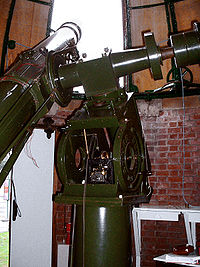- Clock drive
-
Clock drive mechanism in the pier of the german equatorial mount for the 8-inch refracting telescope at Aldershot Observatory.

In astronomy a Clock drive is a regulatory mechanism used to move an equatorial mounted telescope along one axis to keep the telescope in exact sync with the apparent motion of the celestial sky (diurnal motion).[1] They achieve this by rotation the axis parallel to the Earths polar axis (called the right ascension axis) in the opposite direction to the Earths rotation one revolution every 23 hours and 56 minutes (called sidereal day), thereby canceling that motion.[2] The mechanism itself used to be clockwork but now days is usually electrically driven. Clock drives can be light and portable for smaller telescopes[3] or can be exceedingly heavy and complex for larger ones such as the 60 inch telescope at the Mount Wilson Observatory.[4] Clock-driven equatorial platforms are sometimes used non-tracking type mounts, such as altazimuth mounts.[5]
Notes
- ^ Definition
- ^ Turn left at Orion: a hundred night sky objects to see in a small telescope ... By Guy Consolmagno, Dan M. Davis, Karen Kotash Sepp, Anne Drogin, Mary Lynn Skirvin, page 204
- ^ Oltion, Jerry, The Trackball Mount, http://www.sff.net/people/j.oltion/trackball_mount.htm, retrieved 13 March 2011
- ^ 60 inch clock the old Mount Wilson telescope clock drive
- ^ Vogel, Reiner (2007), Circle Segment Platform (link from his English language page), http://www.reinervogel.net/index_e.html, retrieved 13 March 2011
See also
Categories:- Astronomy stubs
- Telescopes
Wikimedia Foundation. 2010.

